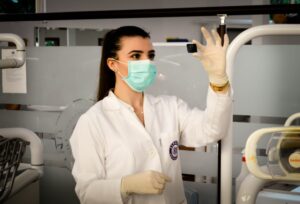From a technology viewed with suspicion, as initial claims pointed towards replacing healthcare professionals, AI has come to be seen as a new way to see and support diagnosis faster and one that never “needs sleep”.
AI remarkable improvements in healthcare and medical diagnostics include maximized effectiveness in the workplace, along with a drop in overload for working professionals. The development of diagnostic devices using AI and IoT (Internet of Things) streamlines the process and enables remote patient monitoring even in locations where medical diagnostic support services are scarce or difficult to access.
The use of AI and IoT allows a decrease in the costs of performing various tests, and also reduces the waiting time in obtaining results, while maintaining high-quality standards and ensuring the monitoring of biomedical teams in real-time.
In this sense, to create an ecosystem for the development of AI in health it is important to network and involves health professionals, patients, and technology in the search for effective solutions with high clinical accuracy. Through these cooperation networks, it will be possible to build trust between the technology industry and the medical community.
AI in medical diagnosis, aids and accelerates medical decision-making, management, administration, and workflows. It succeeds in diagnosing various conditions, flag abnormalities, helping healthcare professionals more quickly prioritize life-threatening cases, diagnosing cardiac arrhythmias, predicting stroke outcomes, and aiding in the management of chronic or acute diseases.
In the never-ending story of customer education, a new chapter is beginning. We can see AI automating repetitive tasks with the development of automated consumer contact platforms and intelligent chatbots in this new emotional AI era.
In some cases, this will realize the replacement of basic functions with intelligent AI, however, human intervention is nothing to ignore. Machines have the potential to meet the threshold, but the human component is a differentiating factor for customers who favor interaction with a person.
And how are bots progressing? Bots enable an increasingly clinical understanding of the customer’s real-time emotional state (including their emotional associations to particular brands) and the emergence of empathetic services that, driven by cold hard data, provide more human and warmer interactions, at scale and on demand.









